Comics➝The Making Of...
I thought it would be interesting, at least for me, to document the process I follow when creating comics. So, I decided to pay attention while I made one, and the one I chose was Dogs and Cats. The following is not meant as advice for making your own comics, and it's certainly not an essay on comic theory, it is merely documenting how I make comics. Take from it what you will, but hopefully it will be of some interest or use to you.
The Idea
To make a comic we first need an idea for a comic. Inspiration can come from anywhere at any time, and doesn't come to me very often, so when it does I try to note it down somewhere for when I next feel like drawing. Now, in the case of Dogs and Cats it was easy – it wasn't my idea, my brother came up with it and volunteered it to me.

Note the date, 7th February; the comic was finished on 24th February. That's more than two weeks from start to finish, pretty quick by my standards. But still, what on earth was I doing for all that time?
Initial Doodles
First things first, doodle. My doodling weapon of choice is a simple black Biro and whatever paper is to hand. The initial doodles are very quick and as such very rough, but they help give a feel for what might be possible.

There are a couple of possibilities for the panel layout doodled here too, I'll discuss this a bit more below.
Some Research
One of the panels was to be a picture of Laika the dog, but I didn't know what Laika looked like. This was a shame as her story is amazing and heartbreaking. She was the first animal to orbit the earth; launched in 1957 aboard Sputnik 2, it was always going to be a one way trip. Her unwitting bravery helped pave the way for manned spaceflight.
But I digress. I didn't know what Laika looked like, so of course I go to Google Images to find out. In fact it becomes obvious to me that I'm not particular familiar with the details about most of the various types of dog. So I decide it's time to practice, and of course as I don't have a pack of dogs of my own it's back to Google Images.
It's back to the Biro and sketch, sketch, sketch..
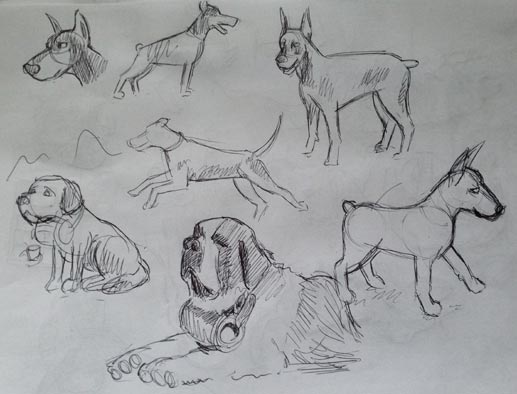
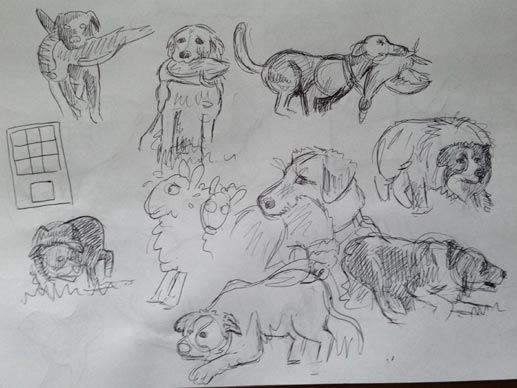
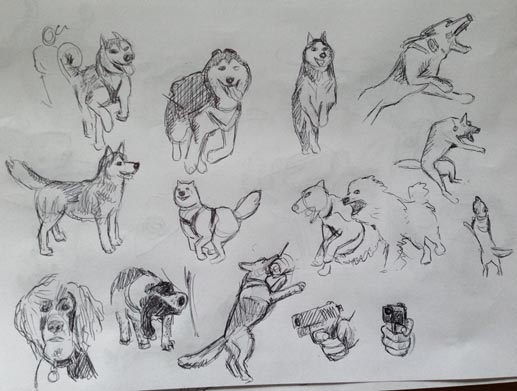
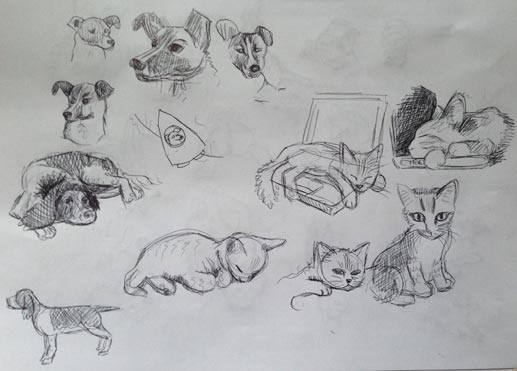

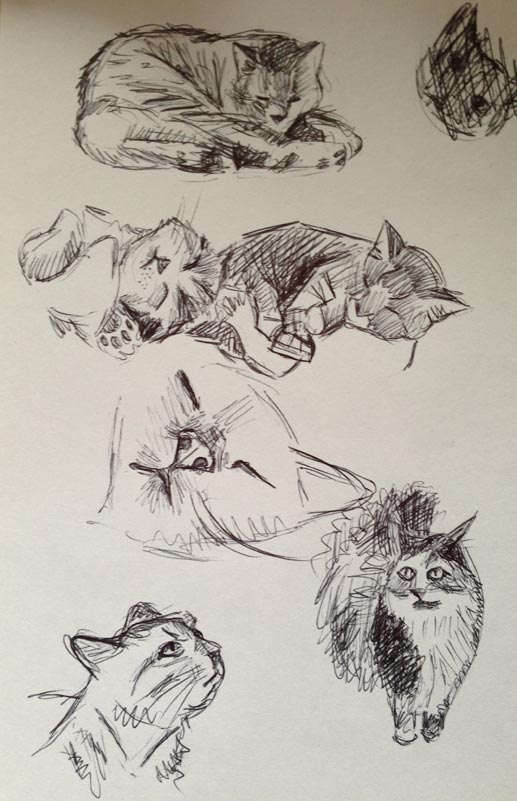

As well as the dogs, I sketched cats lying on things, sheep being sheep, and an angry person. By this stage I have a pretty good idea what all the different aspects of the comic will look like, so it's time to get started on the actual thing.
The Technology
From here on I'm working digitally. I have a Wacom Intuos 3 graphics tablet, A4 sized, which I use for all my digital drawing. As for software, I typically use Macromedia Flash 5. Yes, I know it's from the year 2000, but it's still really good for cartoon style drawings. One great thing is that the drawings are vector based, rather than raster images, so I don't have to worry (as much) about what resolution I'm drawing at, it will scale up without loss of quality. I've tried a few alternative vector based drawing programs, but none came close to Flash.
Deciding on a Layout
The comic starts with a layout. The layout has to look good from a distance as well as allow the story to flow naturally. I abandoned an earlier alternative idea of having the cat in the middle and all the dogs around the outside as the cat panel is the punchline and I felt it would be better placed at the end. A third possibility, having the cat as the final (bottom right) panel in a sequence didn't seem to work either; I felt there needed to be a visual pause (not just paws!) between the dogs and the cat. So I settled on the following:

The cat panel is at the bottom, a little bit larger than the dog panels to emphasise it, and it's surrounded by a bit of a margin – giving the pause.
You'll note I've also drawn an initial sketch of each panel, this helps me work out how big each panel will need to be. It became clear that panels being the same size would not work with the varying scenes they contained. With them all being different sizes I didn't want any of the vertical lines to accidentally line up, or worse, nearly line up. This resulted in a few re-orderings as the drawing progressed, as we'll see later.
Before starting in detail, I check what my brother thinks, as after all it was his idea. We both agree the hunter's retriever could do with a bit more context.

It's now only the 10th February.
The Details
In this comic each panel is pretty much independent of the others. As this is the case I put each one into it's own movie clip, this is just Flash terminology which essentially means that each panel can be treated as a standalone unit which can be moved around in one go and contains it's own set of layers.
I start by taking my rough drawing of the panel, converting it to a light grey an lay it down as my first layer. I can then layer up the drawing on top of this. I typically end up with a few layers, usually at least a separate layer for the background and main characters, sometimes many more depending on the complexity of the scene.
The line drawing is done typically at 200% zoom, this seems to be a happy compromise between control for precision drawing but being able to see enough of the image to get the longer sweeping lines right (in this case the whole comic was scaled down by a further factor at the end, I try and keep it inside 800px width). You probably can't tell but I use pressure sensitivity on the brush size, it feels much more natural.
Once the line drawings are in place they are coloured, I use a combination of fill and paint brush (Flash's "paint behind" and "paint inside" options are particularly handy). To add more depth I usually create a layer for shadow which I draw on with semi-transparent black or other dark colour, and a layer for light using semi-transparent light colours and gradients.

In this panel I had a last minute change of heart, replacing the swag bag with a mobile phone and laptop. I figured thieves don't use swag bags these days, but clearly still wear masks and stripey tops!
It's then a matter of repeating the process for all the panels, perhaps tweaking what they show, or in this case even reordering them, in order to make everything fit nicely. Finally, neaten up the framing of the panels and, hey presto, it's a comic.
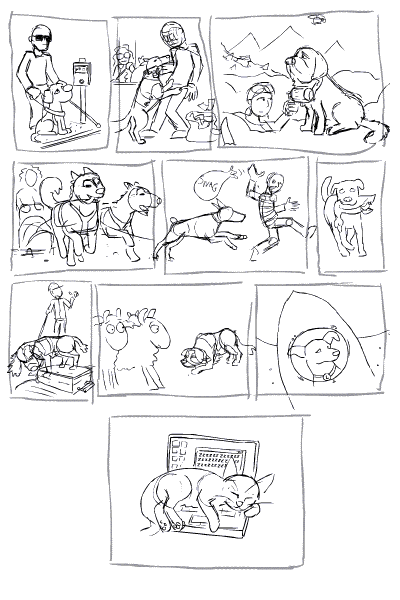
I upload the comic to my site and hope people like it. You can see the finished version of this comic here.
Is this normal?
I don't mean "is making webcomics normal?" lots of people do that, many of them so much more talented than me. I mean was this particular comic representative of my general comic making process? Well it was fairly typical, though certain things do vary.
Some comics I knock up in a day like my smaller ones, or my homages where most of the hard work is already done – I just need a script and to copy the style. Some take much longer, The Equation of Time took over a month, and mid way through creating Reflection I seem to have had several months hiatus!
While this comic and The Department series are collaborative efforts, most of my comics are not. Typically I have to come up with the idea myself and there's no one to run it past before putting it out there.
For this particular comic I did a lot of research sketching, more than usual. Now this was great and extremely useful, but there's one thing that niggles me. It's the poses of many of the animals in the final comic. I found it hard to break away from the poses I'd sketched, as such many of the poses are the same as what they are in the original reference photos. This feels to me a little like cheating. The sniffer dog is actually one I'm most pleased about and its pose was constructed not copied, with hindsight I would've done them all like this.
Conclusion
So, that's how I made Dogs and Cats, and pretty much all my other comics. If you're still reading this far down then hopefully it was of some interest or use to you. If you make comics, what process do you follow? What tools do you use?
